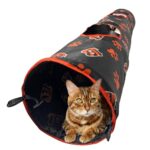Bengal Cats Problems: Common Issues and Solutions
Bengal cats can be prone to health issues such as genetic disorders and behavioral problems. They also require significant mental and physical stimulation.
Bengal cats are a unique and popular breed known for their striking appearance and energetic nature. These felines are a hybrid of domestic cats and Asian leopard cats, resulting in their distinctive spotted or marbled coat. Despite their beauty, Bengal cats come with specific challenges that potential owners should be aware of.
They can suffer from genetic disorders like hypertrophic cardiomyopathy and progressive retinal atrophy. Additionally, their high energy levels necessitate ample playtime and mental stimulation to prevent boredom and destructive behavior. Understanding these needs is crucial for anyone considering bringing a Bengal cat into their home.
Health Concerns
Bengal cats are known for their beauty and playful nature. Yet, they can face certain health problems. Owners need to be aware of these issues to ensure their pets live healthy lives.
Heart Disease
Bengal cats can suffer from heart disease. One common type is hypertrophic cardiomyopathy (HCM). This condition causes the heart walls to thicken. It can lead to heart failure if not treated.
Signs of HCM include:
- Difficulty breathing
- Lethargy
- Loss of appetite
Regular vet check-ups can help catch heart disease early. Medication can manage symptoms and improve quality of life.
Hip Dysplasia
Another concern is hip dysplasia. This condition affects the hip joints. It can cause pain and mobility issues.
Symptoms of hip dysplasia:
- Difficulty jumping or climbing
- Stiffness
- Decreased activity level
Early diagnosis is crucial. Treatment options include weight management, physical therapy, and sometimes surgery.
| Health Issue | Common Signs | Treatment Options |
|---|---|---|
| Heart Disease (HCM) | Difficulty breathing, lethargy, loss of appetite | Medication, regular vet check-ups |
| Hip Dysplasia | Difficulty jumping, stiffness, decreased activity | Weight management, physical therapy, surgery |
Behavioral Issues
Bengal cats are beautiful and energetic. Yet, they can show some behavioral issues. These issues can be challenging for owners. Understanding these behaviors helps in managing them effectively.
Aggression
Some Bengal cats may show aggressive behavior. This can include biting, scratching, or hissing. Often, aggression stems from fear or frustration. Providing plenty of toys and activities can help reduce this behavior.
Here are some tips to manage aggression:
- Offer interactive toys to keep them engaged.
- Create a calm and safe environment.
- Avoid sudden movements or loud noises.
- Consult a vet if aggression persists.
Destructive Chewing
Bengal cats sometimes chew on things they shouldn’t. This is known as destructive chewing. They might chew on furniture, wires, or plants. This behavior can be harmful to both the cat and your home.
To prevent destructive chewing, consider these steps:
- Provide plenty of chew toys.
- Use bitter sprays on items you want to protect.
- Keep hazardous items out of reach.
- Ensure your cat gets enough exercise.
Here is a table with some safe chew toys:
| Chew Toy | Benefits |
|---|---|
| Rubber toys | Durable and safe |
| Catnip toys | Attractive and engaging |
| Interactive puzzles | Mentally stimulating |
Dietary Needs
Bengal cats are unique and have special dietary needs. Their diet must meet their nutritional requirements and avoid food allergies. Proper diet ensures their health and happiness.
Nutritional Requirements
Bengal cats are active and energetic. They need a high-protein diet. Their food should contain 30-40% protein. Look for ingredients like chicken, fish, or turkey.
They also need healthy fats. Fats support their energy levels and skin health. Aim for 15-20% fat in their diet. Omega-3 and Omega-6 fatty acids are beneficial.
Carbohydrates should be minimal. Bengals don’t digest carbs well. Choose foods with fewer grains and more veggies.
Food Allergies
Some Bengal cats have food allergies. Common allergens include grains, dairy, and certain proteins. Symptoms of food allergies are:
- Itchy skin
- Vomiting
- Diarrhea
- Hair loss
If you notice these symptoms, consult a vet. They may recommend an elimination diet. This helps identify the allergen. Feed your Bengal hypoallergenic food if needed.
Always read ingredient labels carefully. Avoid foods with fillers and artificial additives. Choose high-quality, natural ingredients for your Bengal cat.
| Essential Nutrient | Recommended Percentage |
|---|---|
| Protein | 30-40% |
| Fat | 15-20% |
| Carbohydrates | Minimal |
Proper diet keeps Bengal cats healthy and active. Their unique needs require attention to detail in their food. Ensure they get the best nutrition for a happy life.
Litter Box Problems
Bengal cats are known for their energetic and playful nature. However, they can sometimes face litter box problems that can be frustrating for their owners. Understanding these issues can help in finding effective solutions.
Inappropriate Elimination
Inappropriate elimination is one of the most common litter box problems. Your Bengal cat might start urinating or defecating outside the litter box. Several factors can contribute to this behavior:
- Stress or anxiety
- Medical issues like urinary tract infections
- Dirty or unappealing litter box
- Changes in the household environment
To address inappropriate elimination, ensure the litter box is always clean. Also, consult your vet to rule out any medical conditions.
Litter Preferences
Bengal cats can be very particular about their litter preferences. They may refuse to use the litter box if they dislike the litter type. Here are some preferences to consider:
| Type of Litter | Preference Level |
|---|---|
| Clumping Clay | High |
| Silica Gel Crystals | Medium |
| Pine Pellets | Low |
| Recycled Paper | Medium |
Experiment with different types of litter to find the one your Bengal prefers. Some cats may also have preferences for the depth and cleanliness of the litter.
Understanding and addressing your Bengal cat’s litter box problems can lead to a happier, more harmonious household. Take the time to observe and make necessary adjustments to ensure both you and your feline friend are content.
Skin And Coat Care
Bengal cats have a striking coat that requires special attention. Proper skin and coat care ensure they stay healthy and beautiful. This section covers common issues and how to address them effectively.
Allergies
Bengal cats can suffer from allergies affecting their skin. Common signs include itching, redness, and hair loss. These allergies could stem from food, pollen, or even dust mites. Identifying the allergen is crucial. A vet can help determine the cause and suggest appropriate treatments. Sometimes, a change in diet helps. Other times, medication or special shampoos might be needed.
Grooming Tips
Regular grooming keeps your Bengal cat’s coat shiny and healthy. Here are some tips:
- Brush their coat twice a week to remove loose hair.
- Use a gentle brush to avoid skin irritation.
- Check for fleas and ticks during grooming sessions.
- Trim their nails regularly to prevent scratching.
- Bathe your Bengal cat once a month with cat-friendly shampoo.
Proper grooming prevents matting and reduces shedding. It also helps in spotting skin issues early.
Training Challenges
Bengal cats are known for their intelligence and active nature. However, training them can be quite a challenge. Owners often face difficulties with leash training and socialization. These cats need patience and consistency.
Leash Training
Leash training a Bengal cat requires patience. These cats are curious and adventurous. They may resist the leash initially. Start with a harness that fits snugly. Let your cat wear the harness indoors. This helps them get used to it.
Next, attach the leash. Allow your Bengal to walk around inside. Use treats to reward calm behavior. Never pull or drag the cat. Encourage them with gentle tugs and treats. Practice regularly for short periods. Over time, your Bengal will become more comfortable.
Socialization
Socializing a Bengal cat is crucial for their well-being. These cats can be shy or aggressive if not socialized early. Introduce them to new people and pets slowly. Use positive reinforcement like treats and praise.
Start with brief interactions. Gradually increase the time they spend with others. Create a safe space for your cat to retreat if they feel overwhelmed. Consistency is key. Regular socialization helps your Bengal become well-adjusted and friendly.
| Training Aspect | Tips |
|---|---|
| Leash Training | Use a snug harness, practice indoors, reward with treats |
| Socialization | Introduce slowly, use positive reinforcement, create safe spaces |
Environmental Enrichment
Bengal cats are active and intelligent. They need a stimulating environment. Without this, they may become bored or stressed. Environmental enrichment is crucial for their well-being. It includes toys, activities, and safe outdoor time.
Toys And Activities
Bengal cats love to play. Providing a variety of toys keeps them engaged. Rotate toys to maintain their interest. Puzzle feeders stimulate their minds. Interactive toys like laser pointers and feather wands are great.
- Puzzle feeders – Encourage problem-solving and slow eating.
- Interactive toys – Such as laser pointers and feather wands.
- Climbing structures – Cat trees and shelves for climbing.
- Scratching posts – Essential for their claws and marking territory.
Use these toys and activities daily. This helps burn their energy. It prevents unwanted behaviors like scratching furniture.
Safe Outdoor Time
Bengal cats enjoy exploring outdoors. It’s important to ensure their safety. A secure catio offers a safe outdoor space. It protects them from dangers.
Leash training is another option. It allows supervised outdoor time. Always use a harness designed for cats. Never leave them unattended.
| Option | Pros | Cons |
|---|---|---|
| Catio | Safe, secure, and always accessible. | Requires space and initial setup. |
| Leash Training | Allows exploration and exercise. | Needs supervision and training time. |
Safe outdoor time is beneficial. It reduces stress and satisfies their curiosity. Make sure the environment is secure. Always supervise their outdoor activities.
Preventative Measures
Preventing health problems in Bengal cats can be easy. You just need to follow some simple steps. These steps help keep your Bengal cat healthy and happy.
Vaccinations
Vaccinations are very important for your Bengal cat. They protect your cat from many diseases. Your vet will tell you which vaccines your cat needs. Some common vaccines include:
- Rabies
- Feline Distemper
- Feline Leukemia
Make sure your cat gets these shots on time. This will help prevent serious illnesses.
Regular Vet Visits
Regular vet visits are key to a healthy Bengal cat. Your vet can spot problems early. This can save your cat’s life. Most vets recommend at least one visit per year. During these visits, your vet will:
- Check your cat’s weight
- Examine their teeth and gums
- Look for signs of illness
Regular check-ups can help your cat live a long, healthy life.
| Preventative Measure | Benefit |
|---|---|
| Vaccinations | Protects from serious diseases |
| Regular Vet Visits | Early detection of health issues |
Frequently Asked Questions
What Are Common Bengal Cat Problems?
Bengal cats can be prone to anxiety and territorial behavior.
Do Bengal Cats Have Health Issues?
Yes, they can suffer from genetic disorders and heart disease.
Are Bengal Cats Aggressive?
Bengal cats can be territorial and sometimes aggressive.
Why Do Bengal Cats Meow So Much?
Bengal cats are vocal and use meowing to communicate.
How To Manage Bengal Cat’s Energy?
Provide plenty of toys and interactive play sessions.
Do Bengal Cats Get Along With Other Pets?
They can, but early socialization is crucial for harmony.
Why Do Bengal Cats Bite?
Biting can be due to playfulness, stress, or territorial behavior.
Do Bengal Cats Scratch Furniture?
Yes, they often scratch furniture. Provide scratching posts.
How To Reduce Bengal Cat’s Shedding?
Regular grooming helps manage Bengal cat shedding.
Are Bengal Cats Hard To Train?
Bengal cats are intelligent but can be stubborn. Patience is key.
Conclusion
Owning a Bengal cat comes with challenges, but their unique traits make it worthwhile. Addressing their needs ensures a happy pet. Proper care, attention, and understanding can mitigate most problems. Embrace the adventure of having a Bengal cat, and enjoy their playful and affectionate nature.
Your efforts will lead to a rewarding companionship.




